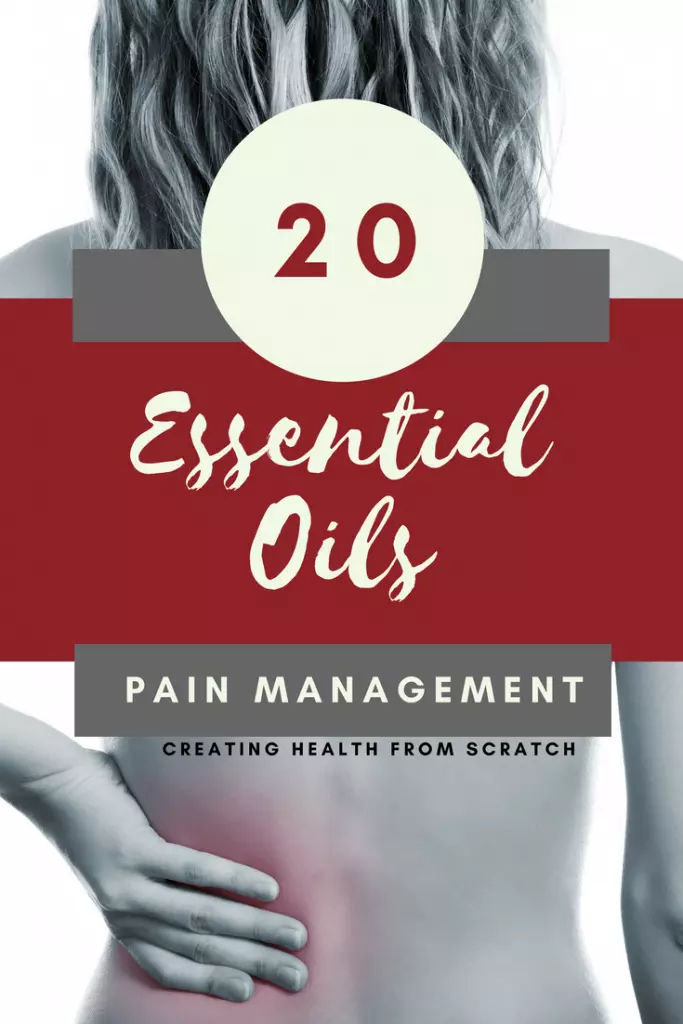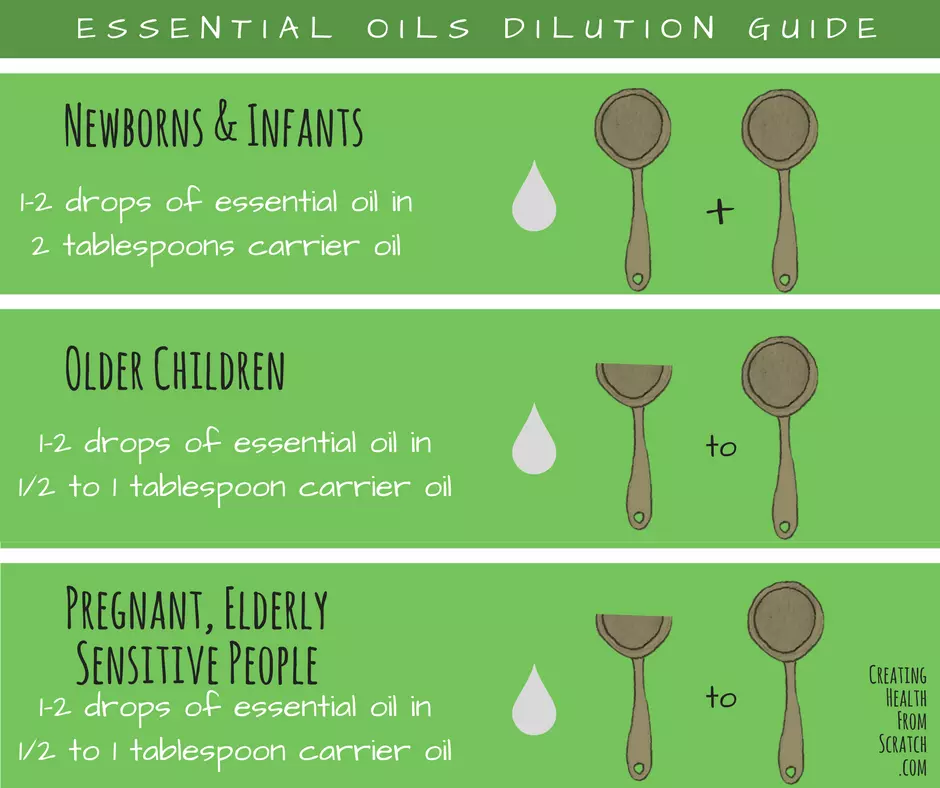
Pain management with essential oils? Absolutely. There are many essential oils that can help manage your pain. There are also several ways to use those oils with pain management. Often, just diluting the oil with a carrier oil (coconut oil, jojoba oil, walnut oil, extra virgin olive oil, etc.) and rubbing it on the area of concern is a good solution. Sometimes using them aromatically is the best (especially for oils that help with calming), occasionally, internal use might be the preferred way. Below is some basic ways to use essential oils as they relate to pain management and below that are 20 oils (listed in alphabetical order) that work in differing ways and with differing specialty.
How to Use Essential Oils for Pain Management
Generally, you can use essential oils topically, aromatically and sometimes internally. Because we’re talking about managing your pain here, though, we will focus on specific applications as they relate to soothing painful areas of the body.
For Head Pain: add carrier oil and massage into temples and back of neck
For Sinus Issues: boil water and dump into a large bowl. Add a few drops of essential oil. Place towel over head and bend down over bowl. Inhale deeply for about 10 minutes. Repeat as necessary.
In Bath (especially good for sore muscles): Add 2-3 cups Epsom salt to bath water. Add a few drops of essential oil mixed with a carrier oil to bath water.
As Massage: Add a few drops of oil to carrier oil and massage into problem areas.
For Hot/Cold Compress: Prepare a bowl of hot water (as hot as you can tolerate) and add a few drops of essential oil. Soak a hand towel in the water, squeeze out the excess water and place hot towel on troubled area. Repeat process with refrigerated or ice water. Alternate hot and cold compresses.
How to Dilute Essential Oils for Use in Pain Management
We just addressed this topic in a blog post of its own, so check it out here. Remember: Less is more with essential oils. Err on the side of caution and dilute more rather than less.
Twenty Essential Oils Good for Pain Management
Basil:
Basil essential oil can help alleviate occasional shoulder, neck and head tension. Basil mixes well with Wintergreen. Use the two together with carrier oil and rub into back of neck.
Basil is also known to help relieve pain associated with monthly feminine issues.
Bergamot:
Bergamot is a great calming oil. Inhaling it helps support your nerves and reduce their sensitivity to pain. It also helps uplift your mood.
Black Pepper:
Black pepper supports healthy blood circulation to painful areas. Mix with carrier oil and apply topically to area of concern.
Clary Sage:
Clary Sage is a great oil for pain associated with a woman’s feminine issues. Mix with carrier oil and apply topically to area of concern.
Clove:
Use Clove oil for near instant relief from tooth pain and throat discomfort. Apply topically to painful tooth area or add a couple drops to a glass of warm water and gargle with it.
Clove is also good for soreness that comes from over using muscles. Mix with a carrier oil and massage into sore muscles.
Clove oil carries the highest antioxidant levels of any other oil and helps support your body in many beneficial ways.
Deep Blue (Soothing Blend):
Deep Blue is an oil blend (it also comes as a rub) made up of wintergreen, camphor, peppermint, ylang ylang, helichrysum, blue tansy, blue chamomile and osmathus. Use it before and after exercise to help support muscles. Especially good for feet, knees and lower back.
Before bedtime, rub into legs of children during their growth spurt stages to help manage discomfort.
Great for lower back soreness as well as tension in shoulders and neck.
Frankincense:
Frankincense is good for nearly anything. One thing it helps with in the area of pain is to support healthy circulation to the painful areas which helps your body recover and heal faster.
Ginger:
Ginger is known for its ability to help calm the raging stomach. But it does more than just that. It helps reduce pain and stiffness in joints and connective tissue and its antioxidants support a healthy body.
Helichrysum:
Helichrysum can actually help reduce the discoloration associated with injury. It’s soothing for occasional nerve pain as well as a great topical support to your over-exposed skin during hot summer days.
Juniper Berry:
Apply Juniper Berry to relieve occasional joint and connective tissue pain.
Lavender:
Lavender is a calming oil that actually helps your body relax. Apply it to your head, neck and/or shoulders to relieve tension. Inhale it to help relax. Sometimes just ridding your body of all that tension takes some kinds of pain away. This oil is also good for soothing skin discomfort.
Lemongrass:
Lemongrass is a mood boosting oil which also helps relieve sore muscles.
Marjoram:
Use marjoram oil on over extended muscles, especially in the hands and legs. Mix with a carrier oil and massage into problem areas.
Peppermint:
Peppermint helps support the body’s digestion so it’s great to use on an unsettled stomach. It soothes the lining of your stomach to help it regain its balance.
Peppermint oil is also helpful in unclogging head stuffiness and soothing lower back pain.
Another added benefit of peppermint oil is that it can be used after other oils to help drive the first oil deeper into the problem area and enhance its effectiveness (plus it smells great).
Roman Chamomile:
Roman Chamomile is known as an overall body soothing oil. It helps to calm down every system—mind, body and skin. Apply to bottoms of feet at bedtime or add a drop or two of the oil to herbal tea.
Rosemary:
Apply rosemary topically to reduce occasional joint and muscle aches and pains.
Sandalwood:
Sandalwood is the go-to for skeletal related pain as well as muscle pain.
Thyme:
Thyme helps relieve pain and discomfort from women’s monthly feminine issues. It also helps create peace of mind for restful sleeping. Dilute with a carrier oil when using to avoid sensitivity.
Vetiver:
Vetiver is a soothing oil. It helps with getting a good night’s rest. But it’s also good at supporting the circulatory and nervous systems in the body which in turn helps relieve aches and pains.
Wintergreen:
Wintergreen helps revive muscles after exercise. It also helps uplift emotions. Use with a carrier oil to avoid sensitivity.
You will notice that many of the essential oils listed are good for similar/same/overlapping issues. This is good news. Your body is unique and the reason you’re experiencing pain (even in the same exact place as someone else) could be quite different from someone else. So, more than one possible solution will give you more options for your particular pain management issue.
If nothing is working for you, check out this post Seven Reasons Why Essential Oils Don’t Work to see if you can find a reason for its ineffectiveness. And lastly, experiment (smartly). You might get lucky and find the perfect oil for you immediately. But it might take some trial and error. Don’t give up. Finding a solution that is life-giving (instead of toxic and synthetic) is worth the time in experimenting!


